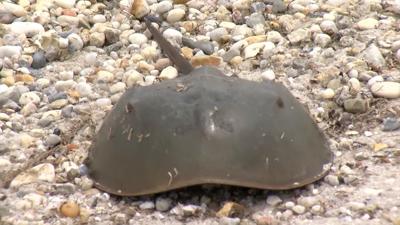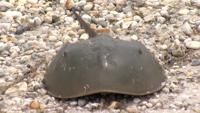Horseshoe crab spawning season is underway, and the Maryland Coastal Bays Program is promoting a horseshoe crab response team program this year to help protect this species.
Most aquatic animals, except aquatic mammals and reptiles, reproduce through a process called spawning. The spawning activity can be problematic for the horseshoe crab as there is a mortality rate that occurs due to excessive energy expenditure, and then to add to the mix, there are some areas in the coastal bays that have obstacles that cause the horseshoe crabs to become stranded while spawning. It could lead to a large number of deaths which is why MCBP is establishing a team of volunteers to go out to these locations and help rescue stranded horseshoe crabs.
Although they are referred to as crabs, they are not crabs, they are more closely related to spiders.
Horseshoe crabs have nine eyes and are made up of three distinct sections: the head which contains all their major organs, the abdomen that contains the gills and muscles to move them about, and the tail which is called a telson. Horseshoe crabs are ecologically important and are harmless to humans. Their telson may look sharp, but it does not sting like a stingray; it is mainly used for maneuvering and helps to turn the crab upright when he or she gets flipped over.
A single female horseshoe crab can lay 90,000 eggs; only about ten of these babies will survive to maturity. What happens to the rest of them? Their tiny pearl-like eggs are a critical food source for many species of migrating shorebirds, turtles, and fish.
In addition to being an important food source to many species throughout the Coastal Bays food web, horseshoe crabs provide humans with a valuable resource to public health; Limulus amebocyte lysate (LAL). This substance is extracted from the horseshoe crab’s blue-colored blood, which is blue due to the blood being copper based instead of iron based like human blood. We use LAL in the biomedical industry to test for the presence of bacterial toxins. The discovery of this life-saving substance occurred in 1971.
Since then, all vaccines, injectable drugs, intravenous solutions, and implantable medical devices that are certified by the Food and Drug Administration are required to be tested using LAL. Horseshoe crabs are also harvested to be used as bait for American eels and whelks.
If you see a horseshoe crab stuck in the rocks, feel free to pick it up by grabbing each side of the shell and put it back into the water, this will help it out tremendously. Never pick up a horseshoe crab by its tail (telson); this will result in injury to the animal.







